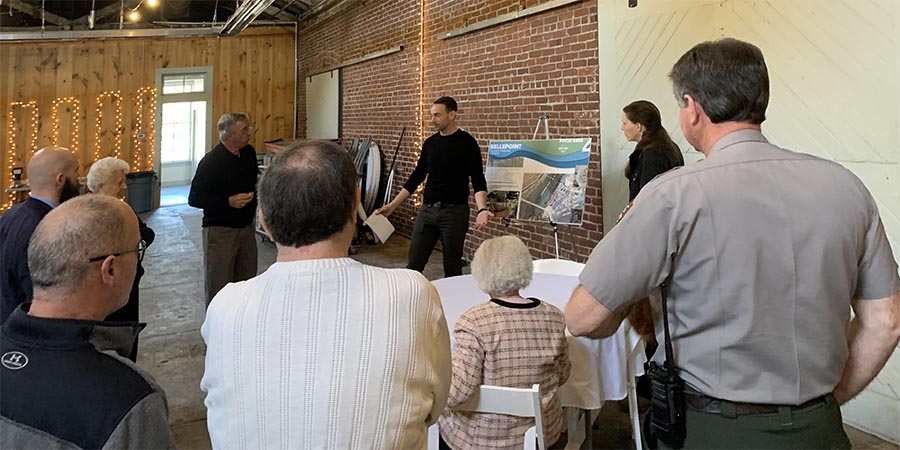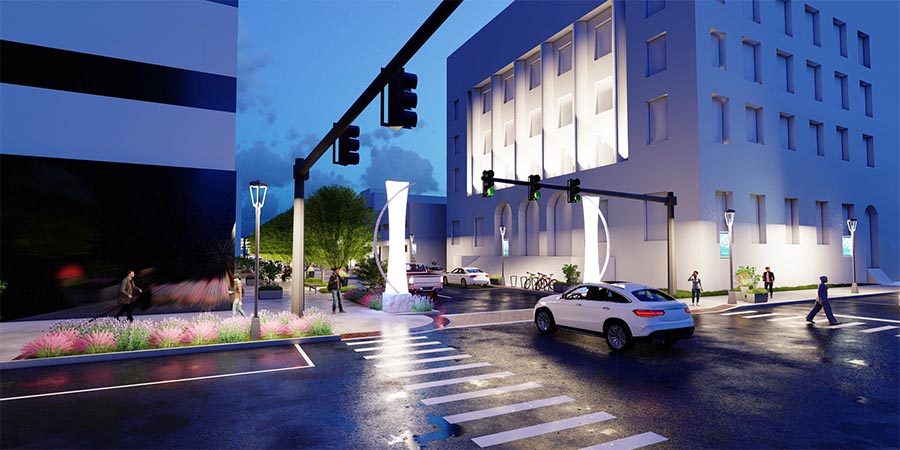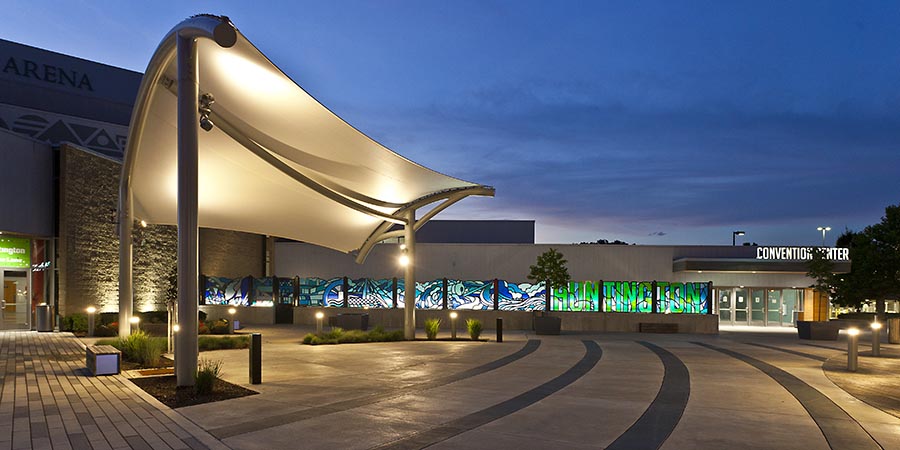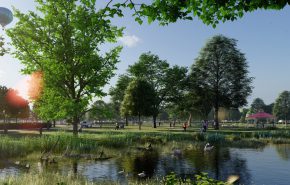GAI Community Solutions Group professionals James Yost, Jacob Burns, and Laura Smith discuss West Virginia historic downtown repositioning initiatives to improve quality of life for residents while helping encourage and accommodate increased tourism.
Historic downtown repositioning initiatives driven by GAI’s Community Solutions Group (CSG) are building new possibilities in municipalities across West Virginia. As a new study shows interest in migration to the state trending consistently positive and West Virginia’s Tourism Secretary announces a state impact on tourism topping $7B in 2022, several historic downtown repositioning initiatives are underway in the state, including GAI CSG projects in Charleston, Elkins, Hinton, and more.
“With the resurgence of tourism and rising inward migration, interest in revitalizing West Virginia’s urban areas has become a trend,” said GAI CSG Landscape Architect Manager James Yost, PLA, ASLA, who serves clients from the firm’s Charleston, WV location. “The primary goal of a historic downtown repositioning initiative is to make these urban centers into more beautiful, safe, functional, and inclusive public spaces for community residents—and creating more attractive tourist destinations in the process is a very positive additional outcome.”
Holistic Historic Downtown Repositioning

“We benefit from active communities, and we work with a lot of cities and smaller towns that in many cases have experienced significant population reduction over the years. With inward migration to West Virginia trending positive as of late, historic downtown repositioning initiatives seek to bring new life into the region to benefit existing and potential residents as well as visitors,” said GAI CSG Assistant Landscape Architect Manager Jacob Burns, PLA, ASLA. “The goal is to have active communities where people want to live, where people want to move and put down roots, and where tourists and residents can enjoy themselves.” To achieve these goals, a historic downtown repositioning project can incorporate streetscape redesign, green infrastructure stormwater management, ‘road diet’ strategies to better manage vehicular traffic and accommodate a mix of road users including pedestrians and cyclists, public transit strategies, urban trail design, parks and open space design, economic development support, and much more.
Historic downtown repositioning initiatives include projects like Charleston’s Capital Connector, an infrastructure project that will create a two-way cycle lane, improve pedestrian facilities, and help optimize vehicular travel lanes along a 3.5 mile stretch of Kanawha Boulevard. The project will ultimately provide a safer connection for cyclists and pedestrians between Charleston’s East End and West Side, while also creating a valuable recreation asset for both residents and visitors. A WCHS news piece features Yost leading a recent Capital Connector project public engagement meeting.
Engaging Stakeholders, Focusing on the Big Picture

“Historic downtown repositioning initiatives by definition stand to affect a municipality’s residents and businesses for decades to come, and that’s one reason why we are so very focused on community and stakeholder engagement when pursuing these types of projects,” said GAI CSG Urban Analytics Director Laura Smith, MPA, FRA-RA. “One of our key priorities when we start a project like this is to get the stakeholders around the table early in the process to explore collaborative ways to talk about and find solutions for the real issues that are involved.”
“Getting community buy-in for your project, gathering input, and enabling the stakeholders to stay engaged throughout the project is so important,” said Yost. “You don’t want to reach out to them just once—the stakeholders should remain involved throughout the entire process so they can see that initial development and how their input can evolve our approach. With an involved community, you’re going to have a much better outcome, and everybody stands a far better chance of being happy at the end of the day.”

Burns notes that the progress of a historic downtown repositioning project can seem somewhat slow to some stakeholders, making it important to avoid getting sidetracked along the way: “In projects like this, it’s helpful for stakeholders to know that time, patience, and perspective give you a better idea of what is actually going on than making snap judgments based on individual tasks as they arise,” he said. “These are long-term projects in which a lot of components come together to make the vision a reality. Remain engaged, yet rather than pivoting to tackle each perceived issue or piece of feedback in real time, stay primarily focused on the big picture; obviously issues raised should be addressed, but it helps to move the project ahead more efficiently overall if you remain mindful to step back and let things develop as the project goes on.”
Economic Analytics, Strategy, and Support

“One of the biggest diminishing effects we see in a downtown area—especially in a historic area—is a rise in retail and commercial vacancies,” said Smith. “In an economic development discussion, we can talk about areas that are deficient, we can talk about historical trends, we can talk about performance measures, but ultimately the goal is to maximize occupancy in the existing retail spaces and office buildings and devise strategies to generate recurring revenue by continually encouraging tenancy within those spaces.”

To advance a historic downtown repositioning initiative, GAI CSG provides a range of economic development support services including feasibility studies and impact analysis, real estate positioning expertise, market studies, revenue generation investigation, and helping municipalities identify funding strategies for their projects. To help attract private investment, GAI CSG’s Opportunity Zone Prospectus service creates extensively researched fact sheets that provide potential investors with relevant and easily understood information to support their decision to invest in challenged urban areas through the federal Opportunity Zone program.
“Economic development doesn’t happen overnight, it doesn’t happen in a year—it’s a process and the stakeholders have to be on board,” said Smith. “You need committed property owners, you need committed business owners, you need buy-in from the municipality, and the players have to come to the table willing and ready to dive in and really be a part of the solution.”
Local Expertise, Nationwide Resources
While both Yost and Burns are West Virginia natives who work out of GAI’s Charleston location, the firm’s capacity to perform a wide range of historic downtown repositioning work in the region is backed by its ability to draw upon the skills and experience of nearly 1,000 multidiscipline colleagues around the United States. “You’re going to get a committed team when it comes to working with GAI in West Virginia,” said Yost. “The faces that our clients see at our kickoff meeting are the faces that are going to be with them throughout the entire project. And while there are many aspects to a historic downtown repositioning project that can include civil engineering, environmental studies, roadway engineering, and more, GAI has the expertise available that can make us a single point of service for a broad range of project requirements.”

Working to improve one’s own community can be a highly satisfying experience. “From our office vantage point, we look out at the site of a downtown redevelopment and parks project that we were involved in,” said Burns. “It’s a stark difference from the empty plaza it was just a few years ago: in a formerly neglected space where perhaps a few questionable activities were going on, I now see kids running in a park, laughing and racing to see who can get to the swings first. That illustrates life returning and a community that is welcoming to residents and tourists alike. And speaking as a resident of Charleston, it’s just great to see a living space that people are using and where they’re having fun.”
Contact GAI Community Solutions Group representatives James Yost, PLA, ASLA, 681.245.6482; Jacob Burns, PLA, ASLA, 681.245.8858; or Laura Smith, MPA, FRA-RA, 321.319.3088 for more information about GAI’s range of community and parks planning, landscape architecture, and economics services—message GAI and start the conversation about how our multidiscipline professionals can meet your unique project needs.
![]() James Yost, PLA, ASLA specializes in landscape architecture and urban planning. Operating out of GAI’s Charleston, WV, office he coordinates a range of landscape architecture, planning, and solar energy projects and marketing activities throughout GAI’s northeast operating area. As part of GAI’s Community Solutions Group, James continues to contribute to award-winning designs throughout the region, applying more than a decade of experience on a diverse scope of projects for both the public and private sectors.
James Yost, PLA, ASLA specializes in landscape architecture and urban planning. Operating out of GAI’s Charleston, WV, office he coordinates a range of landscape architecture, planning, and solar energy projects and marketing activities throughout GAI’s northeast operating area. As part of GAI’s Community Solutions Group, James continues to contribute to award-winning designs throughout the region, applying more than a decade of experience on a diverse scope of projects for both the public and private sectors.
![]() Jacob Burns, PLA, ASLA supports client’s project goals with extensive and diverse experience that includes a strong emphasis on streetscape enhancement, urban connectivity, and recreational space design. Jacob holds a Bachelor of Science degree in landscape architecture from West Virginia University and is the president of the West Virginia chapter of the American Society of Landscape Architects (WVASLA.)
Jacob Burns, PLA, ASLA supports client’s project goals with extensive and diverse experience that includes a strong emphasis on streetscape enhancement, urban connectivity, and recreational space design. Jacob holds a Bachelor of Science degree in landscape architecture from West Virginia University and is the president of the West Virginia chapter of the American Society of Landscape Architects (WVASLA.)
![]() Laura Smith, MPA, FRA-RA oversees the research and analysis of market, economic, and demographic data; commercial, industrial, and multi-family performance indicators; census data; and employment statistics for various GAI products. Laura served as a professional municipal planner for 6 years, expanding her expertise to include writing and updating land-development codes, development plan review, comprehensive plan rewrites and updates, comprehensive plan evaluation and appraisal reports, CRA findings of necessity, and redevelopment plans.
Laura Smith, MPA, FRA-RA oversees the research and analysis of market, economic, and demographic data; commercial, industrial, and multi-family performance indicators; census data; and employment statistics for various GAI products. Laura served as a professional municipal planner for 6 years, expanding her expertise to include writing and updating land-development codes, development plan review, comprehensive plan rewrites and updates, comprehensive plan evaluation and appraisal reports, CRA findings of necessity, and redevelopment plans.


